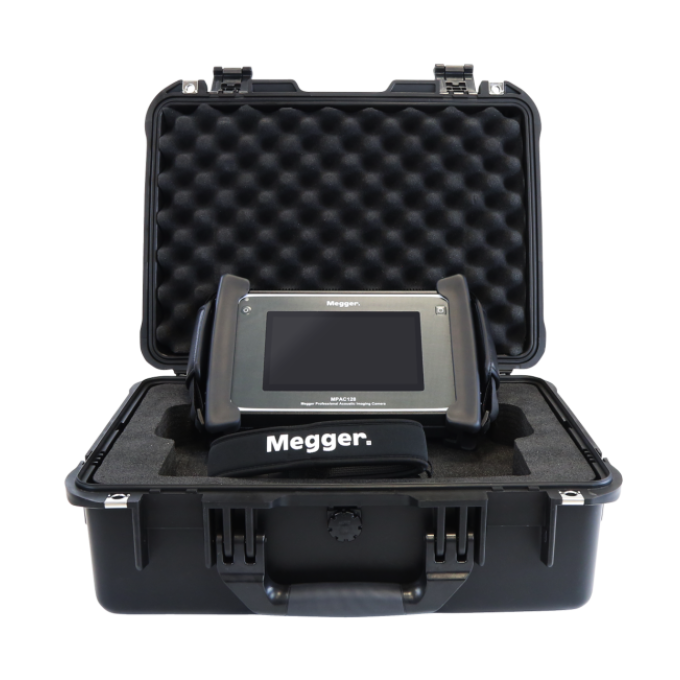New
MPAC128 and MPAC128-ATEX Acoustic Imager
Optimise your efficiency with accurate detection
With 128 microphones, the MPAC128 and MPAC128-ATEX can capture a more comprehensive range of sound information, allowing for precise localisation and analysis of sound sources. This enhanced level of accuracy facilitates efficient troubleshooting, leading to faster problem resolution, reduced downtime, and ultimately improved performance and reliability of the system or equipment being inspected.
Safely detect issues in hard to access areas
Partial discharge and gas leaks can often be found in hard to access areas, such as PD in overhead lines. The 120m detection range enables technicians to safely access any hazardous or hard to access environments - so, for example, there is no requirement for working at height and no need to approach energised conductors - without compromising the level of accuracy. In addition to safety considerations, this can also save you time, when large sections of plants can be surveyed for leaks in just a few minutes, whereas manual inspection to find leaks could take hours.
Work in extreme conditions
The MPAC128 IP54 rating wide operating temperature range from -20 to 50 degrees Celsius makes it well-suited for extreme environments. In addition the MPAC-ATEX can be used in Zone 2 hazardous areas. Whether in industrial settings with explosive atmospheres, outdoor conditions with varying temperatures, or dusty and wet environments, its robust design ensures reliable performance. With these features, the acoustic imager can withstand harsh conditions while providing accurate and safe acoustic imaging for critical applications.



About the product
Megger’s state-of-the-art acoustic imager visualises gas leaks and partial discharge with optimal clarity - helping you address issues before they lead to safety incidents, compliance violations, equipment damage, resource wastage and costly unplanned downtime.
Left undetected, partial discharge (PD) and gas leaks can lead to major failure, explosions, efficiency losses and downstream impacts. Identifying PD issues early prevents very costly unplanned outages, equipment failures, safety hazards and potential regulatory consequences.
This acoustic imaging camera is ATEX-certified and IP54-rated, and offers non-contact detection up to a distance of 120 metres. With 128 microphones and a detection frequency of 2 to 48 kHz, the MPAC128 provides an optimal level of clarity of partial discharge and gas leak detection.
The MPAC128-ATEX is ATEX-certified for use in Zone 2 hazardous areas (II 3G Ex ic IIC T5 Gc), ideal for environments where explosive gases may be present.
FAQ / Frequently Asked Questions
Many types of fault conditions – in particular, gas leaks and partial discharges – produce sounds. Sometimes, the sounds are audible, but more often, they are ultrasonic; that is, they are at frequencies above the limit of human hearing. By ‘listening’ for these sounds, it is possible, in principle, to discover that a fault is present and, by tracing the source of the sound, to find the location of the fault. This is the principle on which acoustic imagers work.
The upper limit of the frequency captured by the device has nothing to do with the number of microphones. Through our test, 48kHz has been found to be suitable for nearly all detection needs. 128 microphones improves the frequency resolution of sound source localisation.
The specified measurement range is 0.5m to 120m, depending upon prevailing conditions (rain/airborne particles etc.). In general, the device performs best when it is positioned between 10 and 20m away from the detection point.
Decay of about 20% for 1000 cycles (Fully charge and discharge). It is standard decay of battery life. Reaching this number of cycles does not automatically mean that the battery will fail. The internal battery can be replaced by authorised service (currently manufacturer only).
Further reading and webinars
Troubleshooting
By looking to see where the leak/PD frequency sits on the spectrum, adjusting the frequency range to eliminate frequencies outside this value and using the focus function all help to give a far more accurate reading or pinpoint the location.
By adjusting the measurement angle and distance, if the acoustic image remains stable on the display, it is a genuine leakage signal and not a reflected leak.
Both air leakage and throttling have a common cause and phenomenon. Both are turbulence caused by sharp changes in the gas channel which result in the generation of sound waves. Therefore, from the acoustic point of view, their characteristics are relatively similar.
In practice, adjusting the dynamic range to see if the acoustic image is distributed along the pipeline indicates that there is a throttling phenomenon. When the leakage point is near the throttling pipe, the location of the leakage point can be confirmed by approaching the leakage point or changing the angle for multi-angle imaging. Using the focus function aids the pinpointing of the leak.
User guides and documents
Software and firmware updates
FAQ / Frequently Asked Questions
No. The ultrasounds generated by the leak are absorbed by the ground and do not propagate to the device sensors. Therefore, it can’t be detected.
No. Liquid leaks usually don't make noticeable sound waves. And if the leak is visible, there's no need for detection, as it can be seen.
No. SF6 leaks are generally at very low pressure and as such do not generate a sound for the camera to detect.
Prolonged use of the device will not affect its accuracy. However, it is recommend calibration is carried out every two years. This may be extended if regular verification of accuracy is carried out using the MPAC-V verifier. Calibration is currently only through the manufacturer.
In general use, choose 20kHz~40kHz to start. When in quieter environments, and the test point is farther away from the equipment, choosing 15kHz~35kHz is the preferred starting point. When in noisy environments, choosing 28kHz~48kHz is advised.












